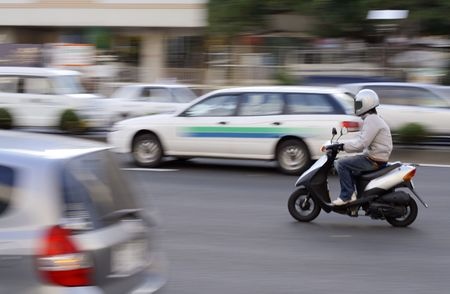Florida - Number 1 in Motorcycle Fatalities - Driving Tips to Share
April 13, 2016 | Category: Motorcycle Accidents | ShareAccording to an NBC-2 report by Levi Ismail on Sunday, April 3, motorcycles account for 7 percent of all vehicles on our roads, but disproportionately make up 19 percent of annual fatalities.
The Florida Department of Highway Safety and Motor Vehicles reports that at least one motorcycle rider dies each day in Florida. Since we have beautiful weather, more motorcyclists are taking advantage of the weather by riding frequently, if not daily.
"Being No. 1 is a terrible ranking when it comes to the tragedy of motorcycle fatalities, and Florida being No. 1 in the United States must be changed," said Fort Myers Motorcycle Accident Attorney, Randall Spivey of Spivey Law Firm, Personal Injury Attorneys, P.A. The following are just a couple of the fatal motorcycle accidents that happened in our state in the last few weeks, and one hit-and-run accident with injuries.
- On March 27, 2016 WINK News reported that a Punta Gorda, FL motorcyclist died in an accident on I-75 near Corkscrew Road when his motorcycle veered off the road and flipped, ejecting the 69-year-old.
- WFTU News in Central Florida reported on March 24, 2016 of the death of a 22-year-old motorcyclist who was a former University of Florida student. The Gainesville police report said that the motorcycle was travelling east when it struck the rear wheel of a box truck that was turning left.
- A local Cape Coral motorcyclist was left by the side of the road with injuries after a vehicle hit him from behind and left the scene. At a fund raiser for him, Keith Pape, another motorcyclist has this message for vehicle drivers, “Just stay away from them. They ride side-by-side. You never know if they are going to swerve or whatever. Just stay away from them. They have no protection."
 “Since many vehicle drivers travelling on the roads in our state come from out-of-state where they encounter fewer motorcycles, we feel it is important to review the 10 ‘Quick Tips’ below from the Motorcycle Safety Foundation. Please share these tips; they are for all car and truck drivers about what to expect when sharing the road with motorcyclists,” said Randall Spivey.
“Since many vehicle drivers travelling on the roads in our state come from out-of-state where they encounter fewer motorcycles, we feel it is important to review the 10 ‘Quick Tips’ below from the Motorcycle Safety Foundation. Please share these tips; they are for all car and truck drivers about what to expect when sharing the road with motorcyclists,” said Randall Spivey.
- Over half of all fatal motorcycle crashes involve another vehicle. Most of the time, the car or truck driver, not the motorcyclist, is at fault. There are a lot more cars and trucks than motorcycles on the road, and some drivers don't "recognize" a motorcycle – they ignore it (usually unintentionally).
- Because of its narrow profile, a motorcycle can be easily hidden in a car’s blind spots (door/roof pillars) or masked by objects or backgrounds outside a car (bushes, fences, bridges, etc.). Take an extra moment to look for motorcycles, whether you're changing lanes or turning at intersections.
- Because of its small size, a motorcycle may look farther away than it is. It may also be difficult to judge a motorcycle’s speed. When checking traffic to turn at an intersection or into (or out of) a driveway, predict a motorcycle is closer than it looks.
- Motorcyclists often slow by downshifting or merely rolling off the throttle, thus not activating the brake light. Allow more following distance, say 3 or 4 seconds. At intersections, predict a motorcyclist may slow down without visual warning.
- Motorcyclists often adjust position within a lane to be seen more easily and to minimize the effects of road debris, passing vehicles, and wind. Understand that motorcyclists adjust lane position for a purpose, not to be reckless or show off or to allow you to share the lane with them.
- Turn signals on a motorcycle usually are not self-canceling, thus some riders (especially beginners) sometimes forget to turn them off after a turn or lane change. Make sure a motorcycle's signal is for real.
- Maneuverability is one of a motorcycle's better characteristics, especially at slower speeds and with good road conditions, but don't expect a motorcyclist to always be able to dodge out of the way.
- Stopping distance for motorcycles is nearly the same as for cars, but slippery pavement makes stopping quickly difficult. Allow more following distance behind a motorcycle because you can't always stop "on a dime."
- When a motorcycle is in motion, see more than the motorcycle – see the person under the helmet, who could be your friend, neighbor, or relative.
- If a driver crashes into a motorcyclist, bicyclist, or pedestrian and causes serious injury, the driver would likely never forgive himself/herself.
Fort Myers Motorcycle Accident Attorney, Randall L. Spivey is a Board Certified Trial Attorney – the highest recognition for competence bestowed by the Florida Bar and a distinction earned by just one (1%) percent of Florida attorneys. He has handled over 2,000 personal injury and wrongful death cases throughout Florida. For a free and confidential consultation to discuss your legal rights, contact the Spivey Law Firm, Personal Injury Attorneys, P.A., in Lee County at 239.337.7483 or toll free at 1.888.477.4839,or by email to Randall@SpiveyLaw.com. Visit SpiveyLaw.com for more information. You can contact Spivey Law Firm, Personal Injury Attorneys, P.A.in Charlotte County at 941.764.7748 and in Collier County 239.793.7748.

